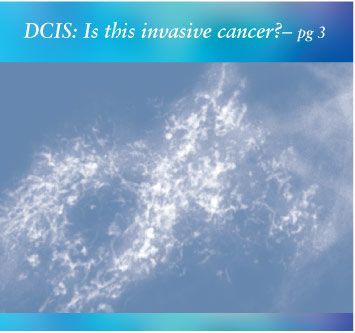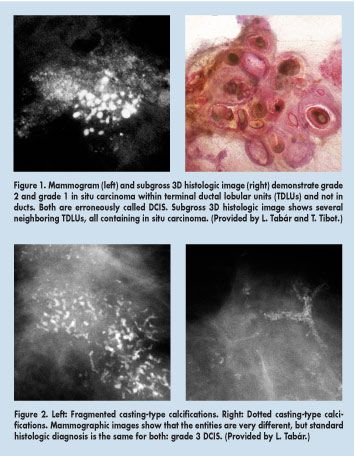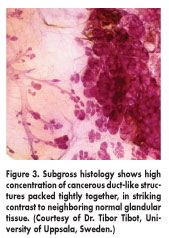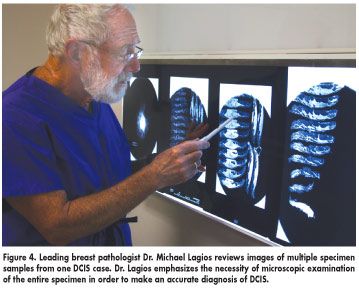Pathology innovations challenge conventional DCIS assumptions and expose its 'true nature'
Conventional wisdom holds that DCIS consists of malignant cells that have not invaded other tissue, but László Tabár, MD, has identified subtypes that he thinks are actually invasive and merely mimic DCIS. Fragmented casting (as seen on the page 1 image) and "snakeskin-like" calcifications, appearing either alone or with a mass on the mammogram, are particularly menacing, he maintains.
Conventional wisdom holds that DCIS consists of malignant cells that have not invaded other tissue, but László Tabár, MD, has identified subtypes that he thinks are actually invasive and merely mimic DCIS. Fragmented casting (as seen on the page 1 image) and "snakeskin-like" calcifications, appearing either alone or with a mass on the mammogram, are particularly menacing, he maintains.

At talks across the United States, Dr. Tabár, a pioneer in mammography education, demonstrates how state-of-the-art mammography, in combination with modern pathology techniques, is exposing the true nature of the many subtypes of breast cancer. A new understanding is emerging of the increasingly detected ductal carcinoma in situ (DCIS), which now accounts for more than one-fifth of all breast cancers in the United States.
"The combination [of mammography and advanced pathology techniques] will revolutionize breast cancer diagnosis," said Dr. Tabár, professor of radiology, University of Uppsala School of Medicine, Sweden.
Large-format pathology
Dr. Tabár is a strong advocate of subgross thick-section 3D histology techniques in combination with large-format pathology. The latter involves analysis of much bigger chunks than usual of biopsy tissue on large slides. Dr. Tabár maintains that these techniques enable better visualization of normal breast patterns, which vary enormously between patients, helping to reduce unnecessary callbacks for benign processes. They also make it possible to correlate mammography, 3D breast MRI, and 3D ultrasound images with pathology findings.
"Accurate measurement of the extent of DCIS has proven difficult with conventional pathologic techniques. MRI and 3D ultrasound create a renewed need for correlative pathology, accomplished with large-format breast pathology techniques," said Lee Tucker, MD, head of pathology and director of the breast care program at Carilion Breast Center, Roanoke, Virginia, a US test-bed facility for Dr. Tabár's theories.
Dr. Tabár considers conventional breast pathology outdated. Modern imaging techniques can demonstrate the entire organ on the film or monitor, while "comparative histology" shows only a 4- to 5-micron-thick, 1.5 1.5-cm piece of tissue. "The type of histologic examination used all over the US is an old-fashioned 200-year-old technique," he said.
There is tremendous resistance to adopting large-format pathology, however. It is viewed as highly impractical, expensive, and akin to throwing away the specialty's standard alphabet. The bigger slides don't even fit on conventional microscopes. Despite the obstacles, a few breast centers that have made the transition say the difficulties are exaggerated and the benefits make it all worthwhile.
"Large-format breast pathology is about much more than the use of larger slides," Dr. Tucker said. "It eliminates the information gap between breast imagers and pathologists by incorporating imaging data into the pathologist's decision making, while preserving regional anatomy and the complex relationship between DCIS and invasive cancer."
A heterogeneous disease
DCIS is sometimes depicted as a homogeneous, mostly harmless entity. For example, when the American College of Physicians changed its guidelines for screening women in their 40s this year, it noted the dangers of overdiagnosis of DCIS, which "seldom results in death."
Many breast imagers and pathologists, however, consider DCIS much like invasive cancer in terms of makeup and heterogeneity. "DCIS is a heterogeneous disease with many subtypes described by one old-fashioned term," Dr. Tabár said. "It's like giving the same name to 10 of your children. It's so simple-minded to say you picked up an innocent something when you don't know what potential it had if you had allowed it to grow. It's hard to tell which cute little kid is going to become a criminal."
3D Histology
Patient information websites by reputable sources inform women that DCIS is confined to the ducts, while lobular carcinoma in situ (LCIS) is confined to the lobules. But 3D histology techniques have shown that both types actually come from the terminal ductal lobular unit (TDLU) (see Figure 1), as noted in a consensus report from the National Institutes of Health Breast Cancer Think Tank (Oncogene 19:968-988, 2000). Cancer can also be localized in the lobules or ducts.

Dr. Tabár thinks it is important to make this distinction in order to match mammography with pathology. TDLUs and ducts have a very different mammographic appearance. "DCIS is a misnomer to begin with. The vast majority of what we call DCIS is actually in situ within the lobule, not ductal," he said.
Dr. Tabár's research indicates that about 75% of lesions currently classified as DCIS have calcifications: powdery (resembling cotton bolls), crushed stone, and casting type (fragmented casting and dotted casting). [See cover art and Figure 2.]
Casting-type calcifications are the most deadly, according to a study of small invasive cancers (1 to 14 mm) by Dr. Tabár and his colleagues, including Robert Smith, PhD, director of cancer screening at the American Cancer Society. The researchers reported that findings associated with casting-type calcifications on a mammogram in tumors 10 to 14 mm resulted in the worst prognosis for the patient: 52% survival over 20 years, compared with 86% to 100% for other mammographic features (Cancer 101:1745-1759, 2004).
Debate on neoductgenesis
Dr. Tabár proposes that some casting-type calcifications on mammography are benign, but most signify that a process called neoductgenesis is taking place, meaning the cancer is forming new ducts or duct-like structures (see Figure 3). When this occurs, the finding is usually diagnosed as DCIS at pathology, even though the process of duct formation is invasive, he said.

Michael Lagios, MD, medical director of the Breast Cancer Consultation Service in the San Francisco Bay Area, questions some of Dr. Tabár's conclusions. "There is not enough evidence to show that high-grade DCIS is invasive," he said. "Whether neoductgenesis occurs is debatable."
New ducts sometimes do growduring puberty, for examplebut they are clearly not invasive, he said. Dr. Lagios points out that for patients with extensive high-grade disease that is accurately assessed, survival rates are essentially 100%. Treatment success for these patients undermines the argument that the cancers are actually invasive rather than in situ.
Cases in which DCIS does turn fatal could represent a missed invasive cancer at the time of diagnosis, he said.
As DCIS is increasingly diagnosed, interest in breast-conserving therapy for the condition is growing, but this requires accurate assessment of margins. In a study of almost 600 women with invasive ductal carcinoma or DCIS, Dr. Tucker and his colleagues noted that large-format pathology increased the extent of DCIS detected to 16.1 mm from 6.1 mm using conventional techniques.
Using philanthropic funding, Orange Coast Memorial Medical Center in California recently adopted large-format techniques.
"With large-format histology, you see disease in one slide rather than chopped up in multiple small pieces. With conventional techniques, it's like admiring the Mona Lisa in nine pieces. Every small one is good but never the same as looking at the entire painting," said Julio Ibarra, MD, medical director of breast pathology at the Orange Coast Memorial Medical Center.
Examine all the tissue
Dr. Lagios argues, however, that conventional techniques can provide the same information as large-format pathology. It will just take a more thorough analysis than is currently being performed.
"With DCIS, I can't see it. I can't feel it. It is invisible, and it may not calcify. The only way to examine it is to examine all the tissue," he said.
Dr. Lagios showed Oncology NEWS International a DCIS case in which 20 specimen samples were microscopically examined, but a small 6-mm area of invasion was evident in only one sample (see Figure 4).

It's like the Vasilopita ritual of the Eastern Orthodox Church, he said. A lucky coin is baked inside a loaf of bread, and on New Year's Day, family members gather and slice the loaf thinly and distribute the pieces one by one.
"Finding invasive cancer is like cutting that bread on New Year's morning. If you only cut three or four slices, the likelihood of getting the coin would be nil. To find invasive cancer, you need to cut the way you cut the lucky bread, in thin slices. And you need to examine each slice carefully," Dr. Lagios said.
Most pathologists look at only a few slices microscopically rather than the whole specimen, due to inadequate reimbursement. "Lack of adequate compensation is a big disincentive for pathologists," Dr. Lagios said.
He also noted that the quality of pathologic assessment is highly variable. "The good thing about imaging is that there are federal quality standards. For pathologists, there are lots of guidelines but no mandated standards. That is the problem with breast pathology in the United States today," he said.
By the end of 2007 or early 2008, the American College of Pathology will come out with a new DCIS protocol that calls for microscopic examination of the entire specimen. Institutions accredited by the American College of Surgeons Commission on Cancer will need to comply, according to the ACP.
Is DCIS an invasive cancer?
To date, most of the mortality benefit from mammographic screening has come from detection of invasive cancers, rather than DCIS. As Dr. Lagios points out, however, earlier detection could enable a less invasive treatment strategy, a benefit not measured in terms of mortality.
Others argue that since invasive cancers start as in situ cancers, increased detection should cut invasive cancer incidence rates in the future. Any decline in future incidence due to the detection and treatment of DCIS would be spread out over many years, making it difficult to measure, said the ACS's Dr. Smith.
Drs. Smith and Tabár are coauthors of a study showing that most DCIS is probably progressive. At the prevalence screen, 37% of DCIS cases were estimated to be nonprogressive, and at incidence screen, only 4% were estimated to be nonprogressive (Yen M-F et al: Eur J Cancer 39:1746-1754, 2003).
"There is an element of overdiagnosis of DCIS in breast cancer screening, but the phenomenon is small in both relative and absolute terms," the authors wrote.
Even low-grade DCIS can eventually progress to invasive cancer. In a study of 28 women with low-grade DCIS not diagnosed at biopsy, David Page, MD, and colleagues found that 11 developed invasive breast cancer in the same breast and quadrant from which their low-grade DCIS biopsy was taken: 7 were diagnosed within 10 years of the biopsy, 1 within 12 years, and 3 over a span of 23 to 42 years (Cancer 103:2481-2484, 2005).
"Evidence now overwhelmingly demonstrates that DCIS is a spectrum of disease ranging from extensive, high-grade lesions, most likely requiring mastectomy for eradication, to small low-grade lesions, which can be cured effectively by excision alone," Dr. Page and his colleagues said in their Cancer article. "It is also clear that there is a middle ground in which excision plus radiation therapy is valid."